Ancient Rome is often known for its trade in two iconic products: wine and olive oil. These items were the main exports of the empire and represented its agricultural wealth. However, the trade of Ancient Rome involved much more than just these famous goods.
This article explores the lesser-known exports that were crucial to the Roman economy. You will learn about a wide range of products — including grains, fish, manufactured goods, and luxury imports — that were essential in maintaining economic vitality throughout the vast empire.
In this article, we will discuss:
- The various agricultural products that supported Roman markets
- The importance of manufactured materials in construction and everyday life
- The flow of exotic goods through major port cities
- The intricate networks and regulations that influenced trade routes
By understanding these aspects, we can see how Roman exports not only brought wealth but also facilitated cultural exchange and unity within the empire. The complexities of trade and economy in Ancient Rome were vital to its vast empire, shaping both daily existence and long-lasting stability.
Additionally, these economic activities were closely connected to the legal systems established during this time period. Ancient Rome has greatly influenced modern legal frameworks, as discussed in our article about the lasting impact of Roman law.
However, it’s important to acknowledge that this empire’s prosperity came with its own set of challenges. As we explore this topic further, we must also examine the factors that contributed to its decline, such as political instability and weak leadership, which acted as a crumbling foundation for this once-powerful civilization.
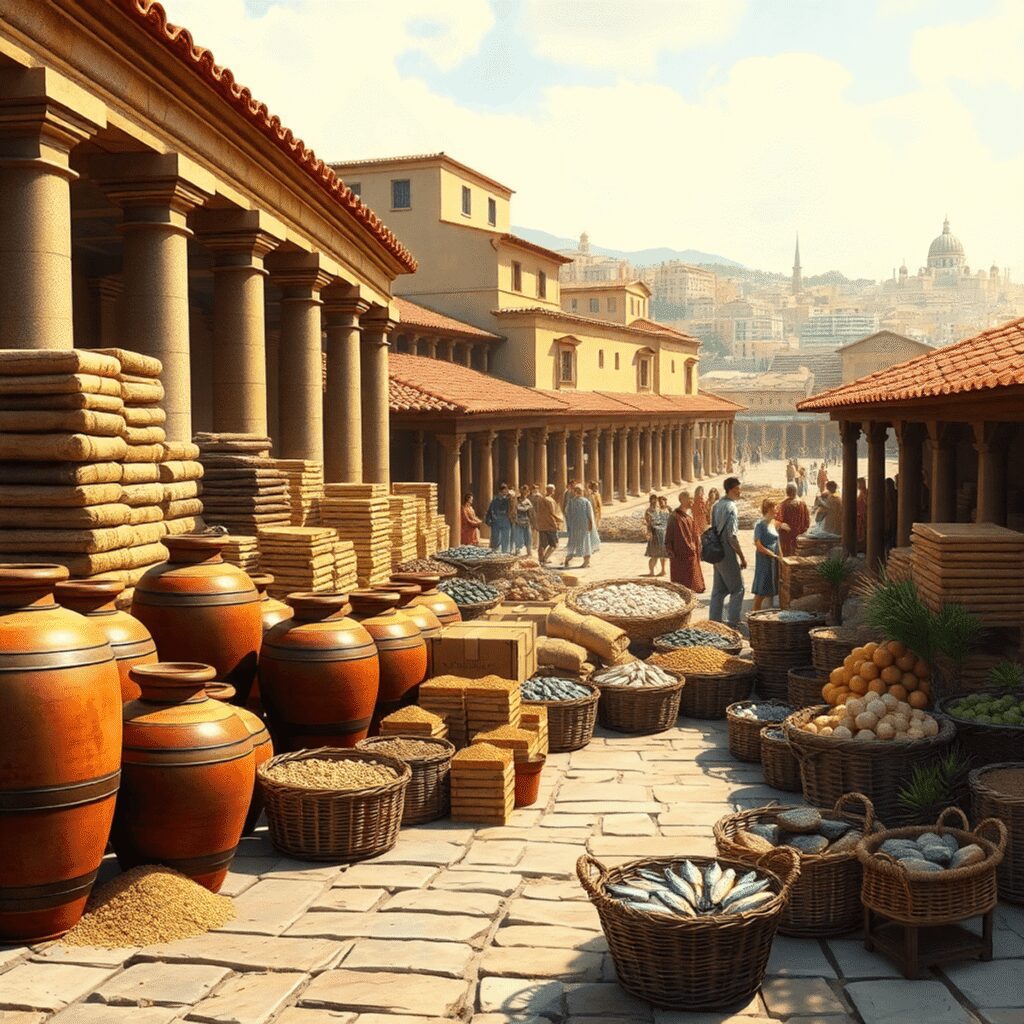
The Staples of Roman Commerce: Wine and Olive Oil
Ancient Rome’s economy was primarily based on two essential products: wine and olive oil. The export of Roman wine not only brought in significant wealth but also served as a means to spread Roman culture and social practices throughout the empire. Amphorae, such as those used for transporting wine, filled with highly sought-after wines were transported from regions like Italy, Gaul, and Hispania to far-off provinces, making wine an integral part of the Roman way of life.
The Versatile Uses of Olive Oil
Olive oil had an even wider range of applications beyond being used as a cooking ingredient. Its adaptability made it an essential part of daily existence:
- Culinary uses: It was crucial for cooking, enhancing flavors, and preserving food.
- Religious practices: Olive oil played a role in anointing ceremonies and offerings at temples, highlighting the strong connection between rituals and sacrifices in Roman religious customs.
- Medical applications: It was used as a healing balm for wounds and skin conditions.
- Mechanical lubrication: Olive oil was utilized to minimize friction in machinery and tools.
The production and trade of these key Roman products showcased the empire’s agricultural knowledge and advanced market systems. The quality of olive oil was meticulously assessed, with various types catering to specific requirements across different social classes and industries. The massive quantities exported each year highlight its vital importance in sustaining urban populations and supporting economic activities throughout the Mediterranean region. In fact, the social and economic value of olive oil extended beyond mere consumption; it was a symbol of wealth and status.
The significance of both wine and olive oil lays the groundwork for comprehending the much wider range of goods that flowed through Roman trade routes.
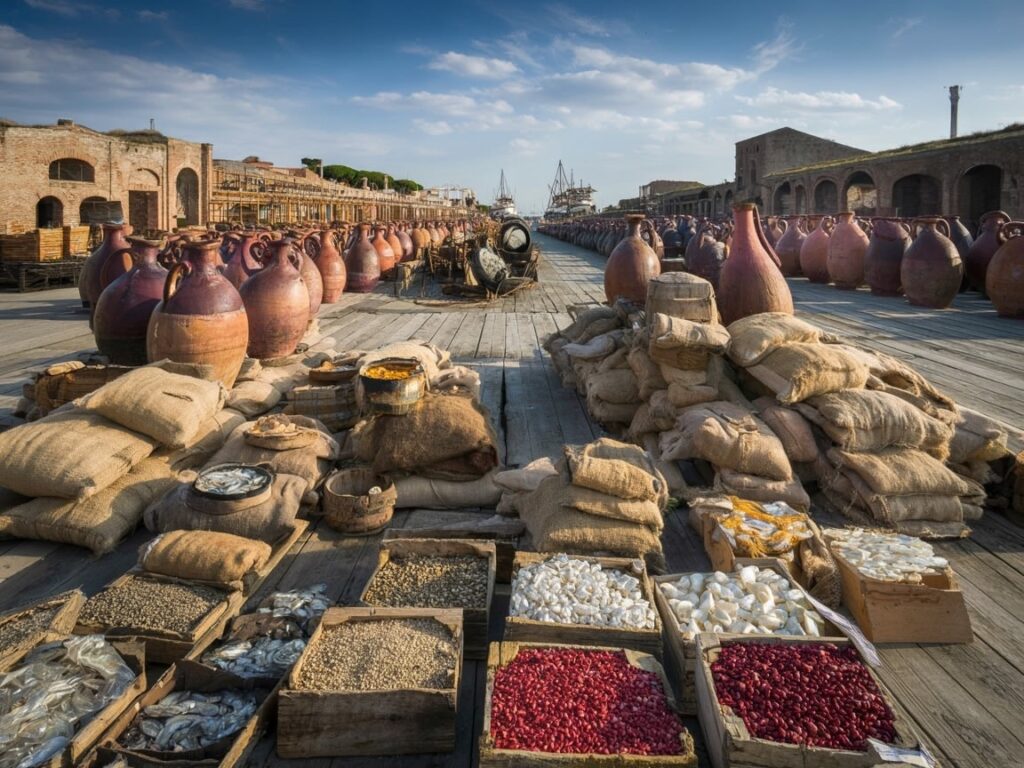
Beyond the Staples: A Diverse Array of Agricultural Exports
Roman cereals trade was a crucial part of the empire’s agricultural economy. Large estates, known as latifundia, specialized in grain production to meet the enormous demand from urban populations and military garrisons. Wheat, barley, and spelt were cultivated extensively, especially in provinces like Egypt, North Africa, and Sicily. These cereals served as essential staples, not only for daily consumption but also for producing bread—the cornerstone of the Roman diet.
Efficient Trade Networks
Trade networks efficiently moved these grain supplies across the Mediterranean. The annona system ensured steady shipments to Rome and other major cities, preventing shortages that could trigger social unrest. Grain exports thus formed a backbone supporting population centers and contributing significantly to economic stability.
Importance of Fish and Meat Products
Fish and meat products held an important place within regional markets. Coastal towns thrived on salted fish such as garum—a fermented fish sauce highly prized throughout the empire for culinary use. Salted and dried meats also circulated widely, offering preserved protein sources beyond fresh produce’s limited shelf life.
A Wide Range of Agricultural Exports
Agricultural goods Rome exported extended beyond wine and olive oil to include these essential foodstuffs that sustained daily life across vast territories. Each commodity played a specific role: cereals provided calories; fish and meat added variety and nutrition; together they reflected an intricate system of production, preservation, and distribution underpinning Roman commercial success.
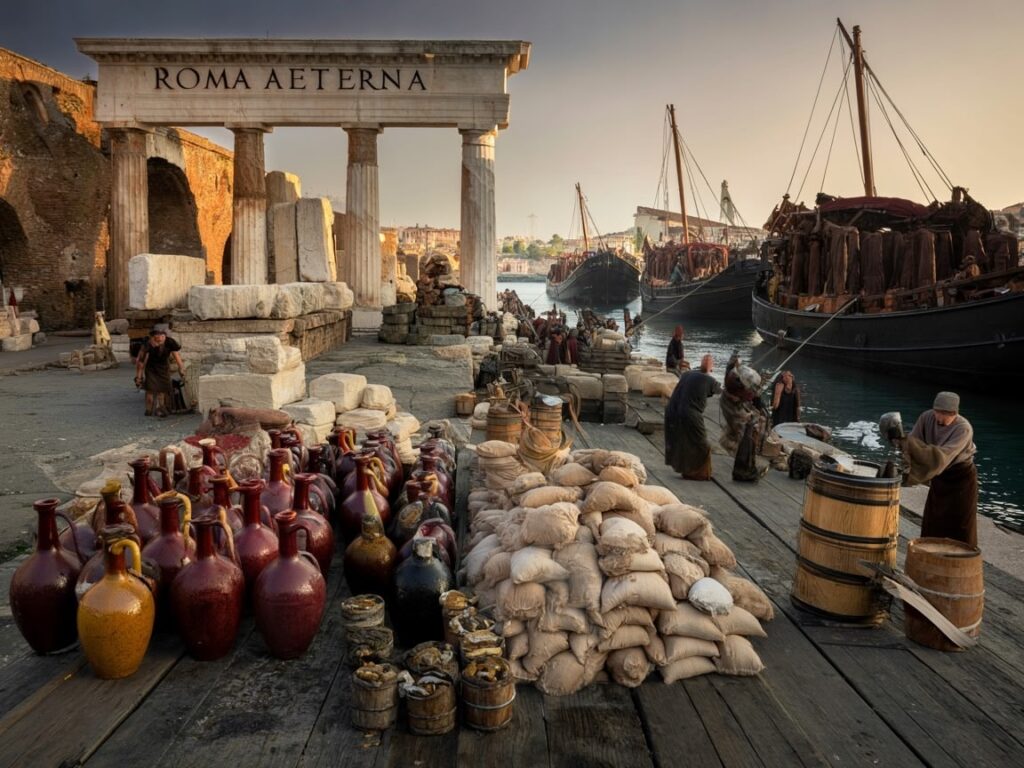
Manufactured Goods and Raw Materials in Roman Trade
Roman manufactured goods were a significant part of Ancient Rome’s Hidden Exports: Trade Beyond Wine and Olive Oil. Skilled artisans produced a wide range of items reflecting the empire’s advanced craftsmanship, which has left a lasting impact on Western civilization.
Manufactured Goods
- Glassware: Ancient glassware from Roman workshops was highly prized both within the empire and beyond. Techniques like blowing and casting allowed for intricate designs in vessels, window panes, and decorative objects. Glass items, often marked with makers’ stamps, circulated widely through Mediterranean trade networks, showcasing Roman innovation in this delicate craft.
- Metal Tools: Metalworking in Rome was sophisticated, producing tools essential for agriculture, construction, and daily life. Iron and bronze tools such as plows, knives, nails, and surgical instruments were manufactured in large quantities. These durable goods not only served domestic needs but were exported to provincial areas lacking local production capabilities.
Raw Materials
Raw materials also fueled monumental architectural projects that defined Roman urban landscapes.
- Timber: Timber was critical for construction, shipbuilding, and fuel. Large forested regions supplied wood cut into beams and planks shipped to cities across the empire. Demand for quality timber supported active logging operations managed by estate owners or the state.
- Construction Materials: Marble quarried from locations like Carrara became synonymous with grandeur in public buildings and monuments. Bricks, tiles, and concrete ingredients were mass-produced to meet the demands of expanding infrastructure such as roads, aqueducts, temples, and forums.
These manufactured goods and raw materials formed an interconnected trade system vital to Rome’s economic strength and architectural legacy. The artistic expression seen in these products can be seen as masterpieces of Roman art, which reflect not only the aesthetic values of its time but also the social, political, and cultural dynamics that shaped the Roman world.
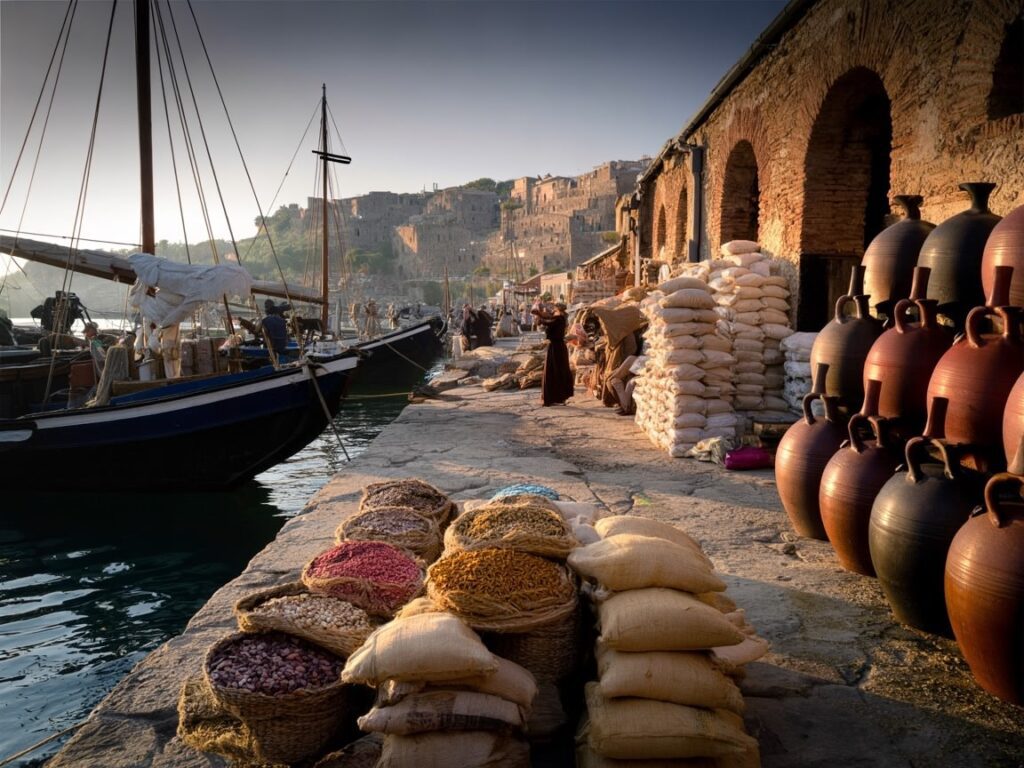
Luxury Items and Exotic Imports Re-exported by Rome
The Roman luxury trade thrived through key Mediterranean ports that functioned as dynamic centers for importing and redistributing exotic goods. Ports such as Gades (modern Cádiz), Ostia, and Alexandria were crucial nodes where merchants brought in coveted items from distant lands before these goods reached Roman consumers.
These ports attracted a wide variety of luxury products, with spices in ancient Rome ranking among the most sought-after commodities. Aromatic substances like cinnamon, pepper, frankincense, and myrrh arrived from Arabia, India, and Southeast Asia. Their rarity and complex supply routes made these spices symbols of wealth and status within Roman society.
Exotic goods did not stop at spices:
- Precious gems and pearls sourced from the East.
- Silk textiles imported mainly through overland routes but also by sea.
- Fine perfumes and incense enhancing religious and social rituals.
- Rare woods and ivory used for crafting luxury furniture and art objects.
Rome acted less as a producer of these items and more as a sophisticated hub for their redistribution throughout the empire. The demand for such exotic goods stimulated long-distance trade networks connecting Rome not only with Mediterranean neighbors but with Asia’s vast markets. This flow of luxury commodities reinforced Rome’s economic dominance while enriching its cultural life with influences far beyond local production capabilities.
The Human Commodity: Slave Trade in Ancient Rome
The slave trade in Rome was a crucial part of the ancient economy, supporting many industries by providing human labor. Slaves were not just possessions; they were essential economic players involved in agriculture, industry, domestic work, and public projects.
Scale and Characteristics:
- Estimates suggest millions of slaves circulated within the empire at its height, acquired through warfare, piracy, trade, and breeding.
- Major slave markets operated in cities like Rome, Delos, and Carthage, facilitating large-scale transactions.
- Slaves originated from diverse regions including Gaul, Germania, North Africa, and the Eastern Mediterranean.
Economic Importance:
- Agricultural estates (latifundia) heavily depended on slave labor for cultivation and harvesting crops such as cereals and olives.
- Urban industries employed slaves in workshops producing textiles, metal goods, and pottery.
- Public construction projects — roads, aqueducts, temples — relied on the steady supply of enslaved workers.
Slaves also worked in households as teachers, skilled workers, or personal attendants. Their labor kept the empire productive by lowering expenses for landowners and merchants. The human labor ancient economy relationship created a complicated system where slaves were both mistreated resources and crucial contributors to economic development.
Roman law governed certain aspects of the slave trade such as ownership rights and treatment but slaves were still at risk of suffering harsh conditions. The extent of this trade shows how closely connected human lives were with Rome’s commercial system beyond just goods and materials.
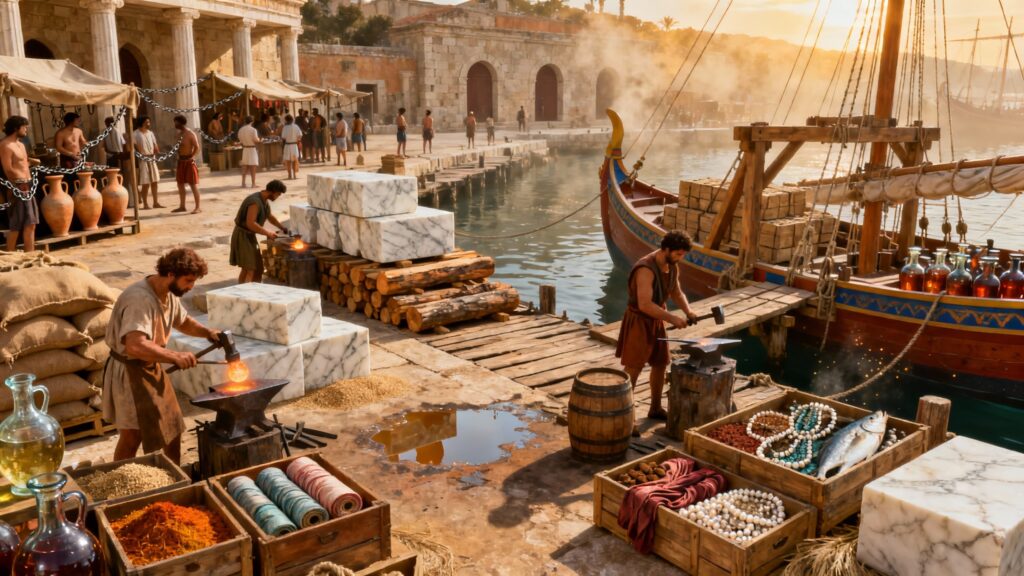
Trade Networks Connecting the Empire to Distant Regions
Roman trade routes extended far beyond the Mediterranean basin, tapping into vast intercontinental exchange systems. The Silk Road ancient Rome connection played a crucial role in linking the empire with distant civilizations across Asia. This extensive land-based network enabled the flow of goods, ideas, and cultures from China, India, Central Asia, and Arabia into Roman markets.
Key features of these trade networks include:
- Intercontinental reach: Goods traveled thousands of miles overland and by sea, passing through multiple intermediaries before reaching Roman ports.
- Diverse commodities: Silk, spices, precious stones, and exotic textiles were among the coveted items transported along these routes.
- Strategic hubs: Cities like Antioch and Palmyra acted as critical junctions where eastern goods were consolidated for onward shipment into the heart of the empire.
- Economic impact: This connectivity fueled demand for luxury products while also introducing new materials that influenced Roman manufacturing and culture.
The Silk Road’s significance lies not only in commerce but also in fostering diplomatic relations and cultural exchanges. Ancient Rome’s hidden exports thrived because these routes supported a robust network that connected producers and consumers across continents. This vast web of interaction underpinned the empire’s economic vitality beyond its well-known maritime trade.
State Regulation and Economic Control over Trade
State control of trade in ancient Rome was crucial for maintaining stability in the empire. One of the key methods used by the government was the annona system, which was specifically designed to manage and secure grain supplies for the growing urban population of Rome.
How the annona system worked
The annona system operated as a distribution network controlled by the state. It ensured a consistent flow of grain primarily from Egypt, North Africa, and Sicily. Public granaries were established to store the grain, and it was distributed either at fixed prices or free of charge to citizens. This approach aimed to prevent shortages and social unrest among the population.
Beyond grain: Monitoring other key commodities
The level of economic control exercised by the Roman government extended beyond just grain. They also kept a close watch on important goods such as olive oil and wine through various means like taxes, tariffs, and official standards.
“The annona was not merely about food security but acted as an instrument of political power, binding the populace to the imperial center.”
Merchants who participated in this system had to adhere to strict regulations concerning quality, weight, and origin certifications stamped on their products. This helped combat fraud and maintain consumer trust throughout the empire.
Balancing state involvement with commerce
Contrary to popular belief, state involvement did not suppress trade; instead, it organized trade networks to benefit Rome’s large urban centers that relied on regular shipments of essential goods. By controlling imports of staple items like grain, the empire could support its population while still allowing private businesses to thrive in other areas.
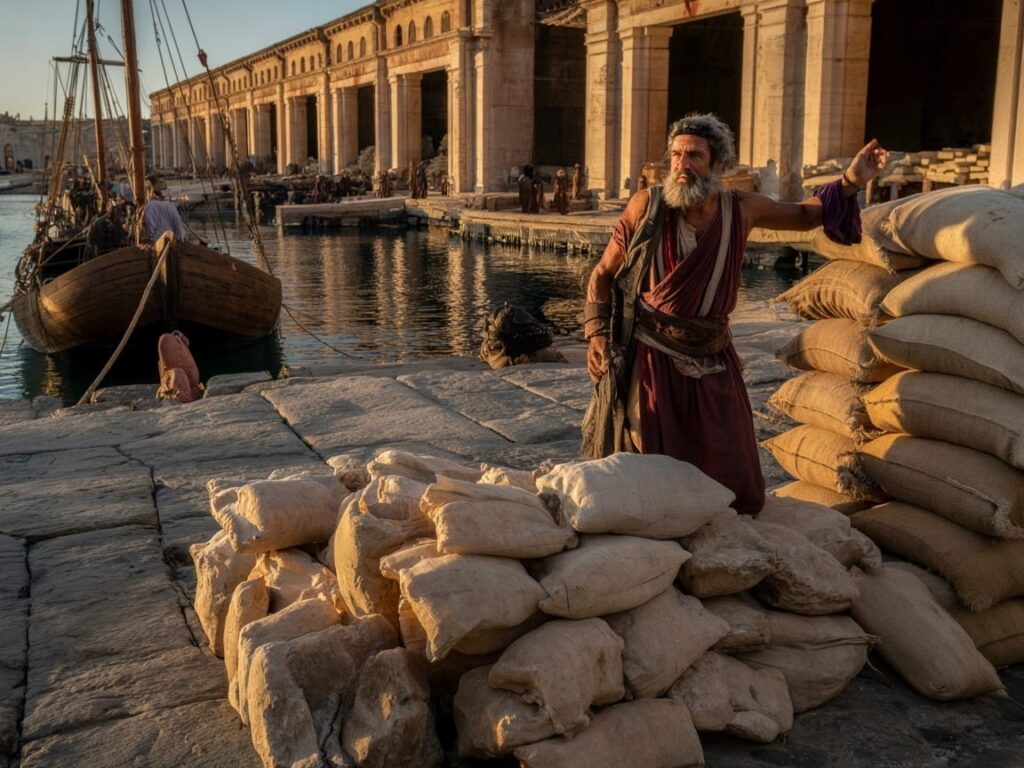
Multifunctional Role of Olive Oil Beyond Export Commodity Status
Olive oil in ancient Rome was much more than just a culinary staple. Its uses extended into daily life, hygiene, and social customs that shaped Roman culture.
1. Bathing Oils for Hygiene and Social Rituals
Romans used olive oil as a cleansing agent in their bathing routines. After exercising or visiting the public baths, citizens would rub olive oil onto their skin before scraping it off with a strigil. This practice removed dirt and sweat, maintaining personal hygiene while also serving as a social ritual in communal bathhouses.
2. Medicinal Uses of Olive Oil in Rome
Olive oil was widely applied for its healing properties. It treated wounds, soothed skin irritations, and served as a base for ointments infused with herbs. Physicians praised its antiseptic qualities and soothing effects on muscles and joints.
3. Fuel for Lamps
Olive oil lit the streets and homes of Roman cities by serving as an efficient fuel for lamps. This extended productive and social activities well into the night, fostering nightlife and commerce after dark. The availability of olive oil for lighting symbolized urban sophistication and economic vitality.
The multifunctional role of olive oil reveals how deeply it was woven into Roman life—not just an export commodity but a vital resource supporting health, social practices, and urban living conditions across the empire.
Conclusion
Ancient Rome’s trade network was vast and intricate, extending far beyond the familiar exports of wine and olive oil. The hidden exports of ancient Rome reveal a complex web of economic activities involving various agricultural products, manufactured goods, luxury items, raw materials, and human labor. This unprecedented scale of commerce connected distant regions across continents, facilitating cultural exchange and economic integration on a remarkable scale.
Understanding these lesser-known goods enriches our appreciation of Roman economic complexity. It highlights how the empire sustained its urban populations, fueled monumental architectural projects, and maintained social customs through a multifaceted trade system. The legacy of these hidden exports offers valuable insights into the sophistication of ancient economies and their ability to manage diverse resources efficiently.
Exploring Ancient Rome’s Hidden Exports: Trade Beyond Wine and Olive Oil opens new perspectives on how interconnected and dynamic the Roman economy truly was—far more than just a story of two iconic commodities.
FAQs (Frequently Asked Questions)
What were the primary staples of Ancient Roman trade?
The primary staples of Ancient Roman trade were wine and olive oil, which were extensively exported and used in culinary, religious, medical, and mechanical contexts.
Besides wine and olive oil, what other agricultural products did Ancient Rome export?
Ancient Rome exported a diverse array of agricultural goods including cereals from large estates that sustained the empire, as well as fish and meat products traded within regional markets.
What manufactured goods and raw materials were significant in Roman trade?
Roman trade included the production and export of glassware, metal tools, timber, marble, and bricks. These materials fueled architectural projects across the empire and showcased Roman craftsmanship.
How did luxury items and exotic imports feature in Ancient Rome’s trade network?
Major ports like Gades, Ostia, and Alexandria served as hubs for importing luxury goods such as spices from Arabia, India, and Southeast Asia. These exotic items were highly coveted and redistributed throughout the empire.
What role did the slave trade play in Ancient Rome’s economy?
The slave trade was a significant aspect of Ancient Rome’s economy; slaves were a traded commodity crucial for sustaining various economic activities across the empire.
How did state regulation affect trade in Ancient Rome?
The Roman government exercised control over trade through systems like the annona system, which regulated grain supplies to ensure food security for urban populations.

